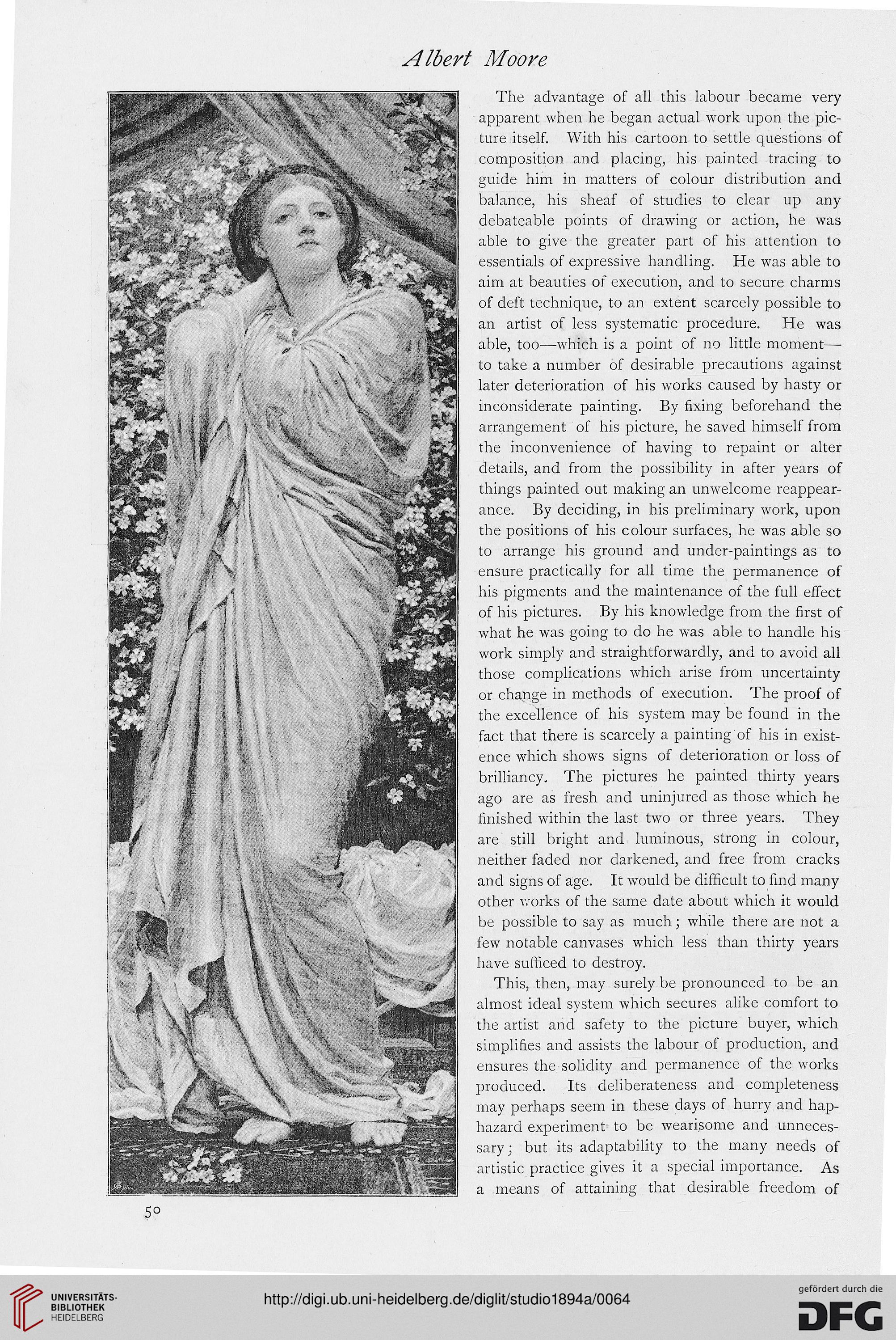Albert Moore
5°
The advantage of all this labour became very
apparent when he began actual work upon the pic-
ture itself. With his cartoon to settle questions of
composition and placing, his painted tracing to
guide him in matters of colour distribution and
balance, his sheaf of studies to clear up any
debateable points of drawing or action, he was
able to give the greater part of his attention to
essentials of expressive handling. He was able to
aim at beauties of execution, and to secure charms
of deft technique, to an extent scarcely possible to
an artist of less systematic procedure. He was
able, too—which is a point of no little moment—
to take a number of desirable precautions against
later deterioration of his works caused by hasty or
inconsiderate painting. By fixing beforehand the
arrangement of his picture, he saved himself from
the inconvenience of having to repaint or alter
details, and from the possibility in after years of
things painted out making an unwelcome reappear-
ance. By deciding, in his preliminary work, upon
the positions of his colour surfaces, he was able so
to arrange his ground and under-paintings as to
ensure practically for all time the permanence of
his pigments and the maintenance of the full effect
of his pictures. By his knowledge from the first of
what he was going to do he was able to handle his
work simply and straightforwardly, and to avoid all
those complications which arise from uncertainty
or change in methods of execution. The proof of
the excellence of his system may be found in the
fact that there is scarcely a painting of his in exist-
ence which shows signs of deterioration or loss of
brilliancy. The pictures he painted thirty years
ago are as fresh and uninjured as those which he
finished within the last two or three years. They
are still bright and luminous, strong in colour,
neither faded nor darkened, and free from cracks
and signs of age. It would be difficult to find many
other works of the same date about which it would
be possible to say as much; while there are not a
few notable canvases which less than thirty years
have sufficed to destroy.
This, then, may surely be pronounced to be an
almost ideal system which secures alike comfort to
the artist and safety to the picture buyer, which
simplifies and assists the labour of production, and
ensures the solidity and permanence of the works
produced. Its deliberateness and completeness
may perhaps seem in these days of hurry and hap-
hazard experiment to be wearisome and unneces-
sary; but its adaptability to the many needs of
artistic practice gives it a special importance. As
a means of attaining that desirable freedom of
5°
The advantage of all this labour became very
apparent when he began actual work upon the pic-
ture itself. With his cartoon to settle questions of
composition and placing, his painted tracing to
guide him in matters of colour distribution and
balance, his sheaf of studies to clear up any
debateable points of drawing or action, he was
able to give the greater part of his attention to
essentials of expressive handling. He was able to
aim at beauties of execution, and to secure charms
of deft technique, to an extent scarcely possible to
an artist of less systematic procedure. He was
able, too—which is a point of no little moment—
to take a number of desirable precautions against
later deterioration of his works caused by hasty or
inconsiderate painting. By fixing beforehand the
arrangement of his picture, he saved himself from
the inconvenience of having to repaint or alter
details, and from the possibility in after years of
things painted out making an unwelcome reappear-
ance. By deciding, in his preliminary work, upon
the positions of his colour surfaces, he was able so
to arrange his ground and under-paintings as to
ensure practically for all time the permanence of
his pigments and the maintenance of the full effect
of his pictures. By his knowledge from the first of
what he was going to do he was able to handle his
work simply and straightforwardly, and to avoid all
those complications which arise from uncertainty
or change in methods of execution. The proof of
the excellence of his system may be found in the
fact that there is scarcely a painting of his in exist-
ence which shows signs of deterioration or loss of
brilliancy. The pictures he painted thirty years
ago are as fresh and uninjured as those which he
finished within the last two or three years. They
are still bright and luminous, strong in colour,
neither faded nor darkened, and free from cracks
and signs of age. It would be difficult to find many
other works of the same date about which it would
be possible to say as much; while there are not a
few notable canvases which less than thirty years
have sufficed to destroy.
This, then, may surely be pronounced to be an
almost ideal system which secures alike comfort to
the artist and safety to the picture buyer, which
simplifies and assists the labour of production, and
ensures the solidity and permanence of the works
produced. Its deliberateness and completeness
may perhaps seem in these days of hurry and hap-
hazard experiment to be wearisome and unneces-
sary; but its adaptability to the many needs of
artistic practice gives it a special importance. As
a means of attaining that desirable freedom of




